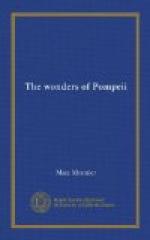“O ye beneficent gods! how many men employed to serve a single stomach!” exclaimed Seneca, who passed in his day for a master of rhetoric. In our time, he would be deemed a socialist.
[Footnote D: So strong was this feeling, that the very name inquilinus, or lodger, was an insult. Cicero not having been born at Rome, Catiline called him offensively civis inquilinus—a lodger citizen. (Sallust.)]
[Footnote E: Let not fingers that are too thick, and ill-pared nails, make gestures too conspicuous.]
[Illustration: Peristyle of the House of the Quaestor at Pompeii.]
VII.
ART IN POMPEII.
THE HOMES OF THE WEALTHY.—THE
TRIANGULAR FORUM AND THE
TEMPLES.—POMPEIAN
ARCHITECTURE: ITS MERITS AND ITS DEFECTS.—THE
ARTISTS OF THE LITTLE
CITY.—THE PAINTINGS HERE.—LANDSCAPES,
FIGURES, ROPE-DANCERS,
DANCING-GIRLS, CENTAURS, GODS, HEROES, THE
ILIAD ILLUSTRATED.—MOSAICS.—STATUES
AND
STATUETTES.—JEWELRY.—CARVED
GLASS.—ART AND LIFE.
The house of Pansa was large, but not much ornamented. There are others which are shown in preference to the visitor. Let us mention them concisely in the catalogue and inventory style:
The house of the Faun.—Fine mosaics; a masterpiece in bronze; the Dancing Faun, of which we shall speak farther on. Besides the atrium and the peristyle, a third court, the xysta, surrounded with forty-four columns, duplicated on the upper story. Numberless precious things were found there, in the presence of the son of Goethe. The owner was a wine-merchant.(?)
The house of the Quaestor, or of Castor and Pollux.—Large safes of very thick and very hard wood, lined with copper and ornamented with arabesques, perhaps the public money-chests, hence this was probably the residence of the quaestor who had charge of the public funds; a Corinthian atrium; fine paintings—the Bacchante the Medea, the Children of Niobe, etc. Rich development of the courtyards.
The house of the Poet.—Homeric paintings; celebrated mosaics; the dog at the doorsill, with the inscription Cave Canem; the Choragus causing the recitation of a piece. All these are at the museum.
The house of Sallust.—A fine bronze group; Hercules pursuing a deer (taken to the Museum at Palermo); a pretty stucco relievo in one of the bedchambers; Three couches of masonry in the triclinium; a decent and modest venereum that ladies may visit. There is seen an Acteon surprising Diana in the bath, the stag’s antlers growing on his forehead and the hounds tearing him. The two scenes connect in the same picture, as in the paintings of the middle ages. Was this a warning to rash people? This venereum contained a bedchamber, a triclinium and a lararium, or small marble niche in which the household god was enshrined.




